Why is there a big red rabbit at Sacramento airport? Here’s the story behind ‘Leap’
Uniquely is a Sacramento Bee series that covers the moments, landmarks and personalities that define what makes living in the Sacramento area so special.
Every time Davis resident Marc Lancet strolls past “Leap,” the giant red rabbit sculpture at Sacramento International Airport’s Terminal B, he snaps a selfie.
“When I go through that terminal, I’m so grateful” that “Leap” is there, said Lancet, a ceramics artist and sculptor who flies through the airport frequently. “The big rabbit is so fantastic ... I look at it and I just have to love it.”
Since ”Leap” was unveiled in October 2011, it has become a symbol of the airport and, by extension, the city.
“‘Leap’ is an iconic piece of art at the airport,” said Scott Johnston, a spokesman for the Sacramento County Department of Airports.
“It’s amazing,” he said. “It’s huge. It’s red. It’s right in the center of one of the most iconic spaces here in the airport.”
Why is there a giant red rabbit at the airport? And how did it get there?
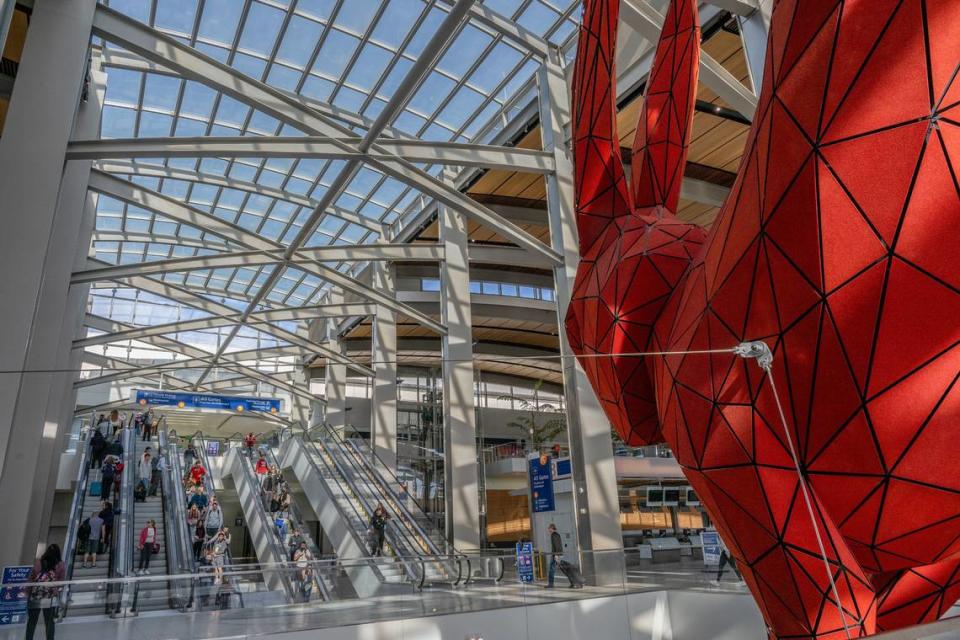
What is ‘Leap,’ the giant red rabbit at Sacramento airport?
Visible from the mezzanine level of Terminal B, “Leap” features a massive rabbit suspended by steel cables from the ceiling over the escalator.
Caught in mid-jump, the big bunny appears to be bounding toward a granite suitcase the size of a queen bed in the baggage claim area. The suitcase is topped with a swirling vortex that frequently collects spare change.
The sculpture was created by Denver-based artist Lawrence Argent, whose best-known artworks include “Venus,” a twisting, tower-like sculpture in San Francisco inspired by the Venus di Milo, and “I See What You Mean,” the big blue bear sculpture outside the Colorado Convention Center.
“I wanted to play around with the idea that something has come from the outside and leapt into the building,” Argent told the Associated Press in 2011. “Scale, position, all had something to do with becoming one with the architecture and not a separate entity.”
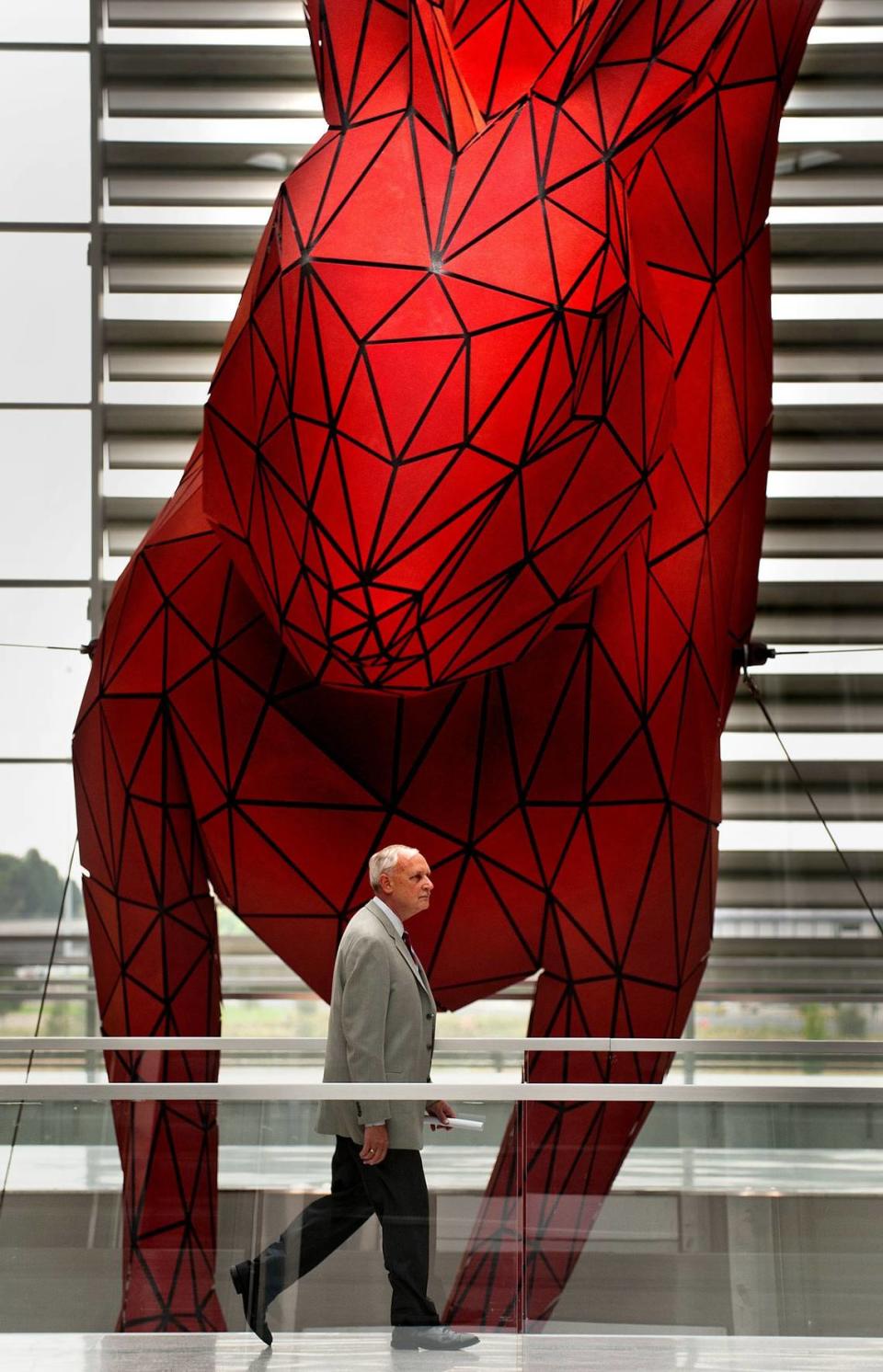
Argent worked with Kreysler & Associates in American Canyon to bring his creation to life.
Although Argent originally designed the rabbit as a fiberglass form composed of hundreds of flat triangles, he switched to aluminum to meet the airport’s safety requirements.
“Leap” actually consists of two bunnies, including an “all-aluminum monocoque version of the rabbit used as an armature to support” the decorative surface layer, Kreysler & Associates said on its website.
Floating 1.5 inches above the interior shell are 1,446 machine-cut aluminum triangles with side dimensions ranging from 1 inch to 3 feet, The Architect’s Newspaper reported in 2011. The tiles are “textured with crushed glass to create a velvet-matte surface,” the publication said.
“Leap” is crisscrossed with black lines that mimic Spider-Man’s superhero costume, prompting some to dub it “Spider-Bunny.”
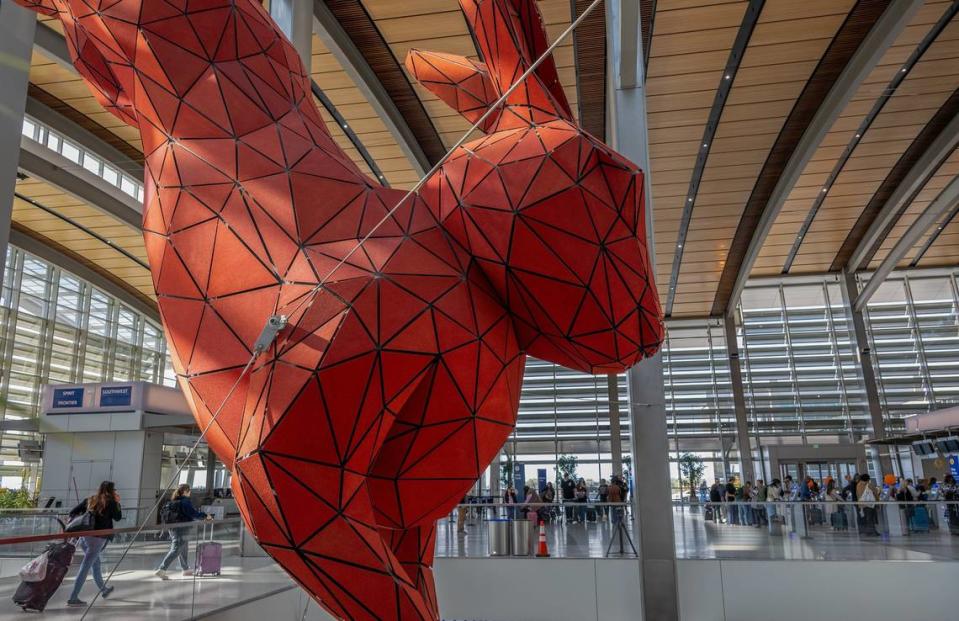
Why a rabbit?
Argent, who died in 2017, said he chose a rabbit because of the animal’s association with mythologies from around the world.
“The rabbit has so many meanings to so many different cultures,” said Shelly Willis, public art planning and project management consultant for the Sacramento County Airport System.
They range from the White Rabbit in “Alice in Wonderland” to the trickster hare of African folklore.
“Leap” pairs the lagomorph with a whorl-topped “vortical suitcase” to explore the concept of baggage, both physical and psychological, Argent said.
“That suitcase is really a symbol of what we carry with us on their trips,” said Willis, the former public art program manager for the Sacramento Metropolitan Arts Commission, now known as the Sacramento City Office of Arts and Culture.
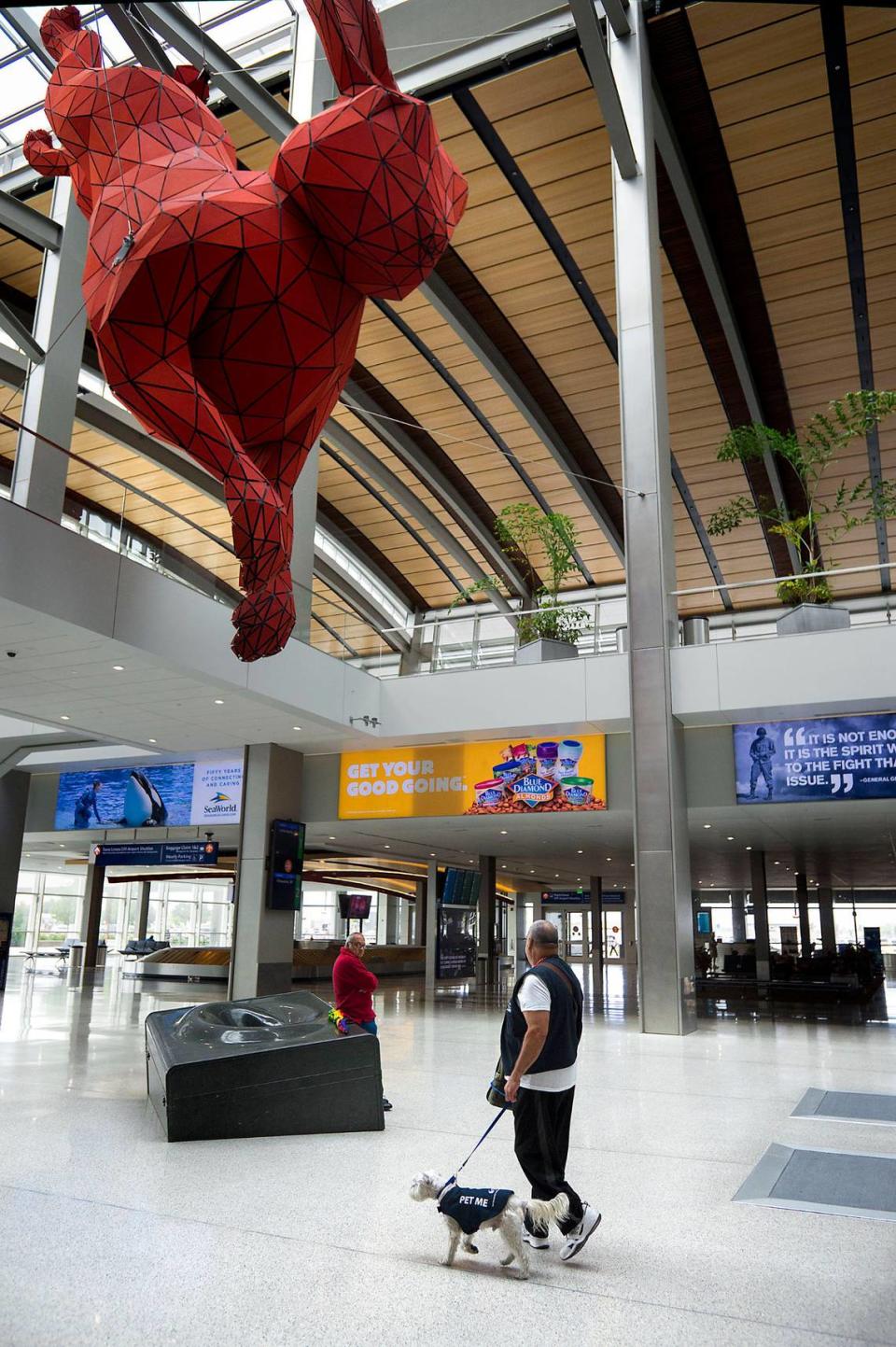
Why is it red?
Interviewed in 2011, Lawrence said he chose a color that felt “fast.”
“It needed to have the acceleration of a Ferrari, and that somehow stuck in my head,” he told the Associated Press.
“The color is just right,” Willis said, combining speed and softness.
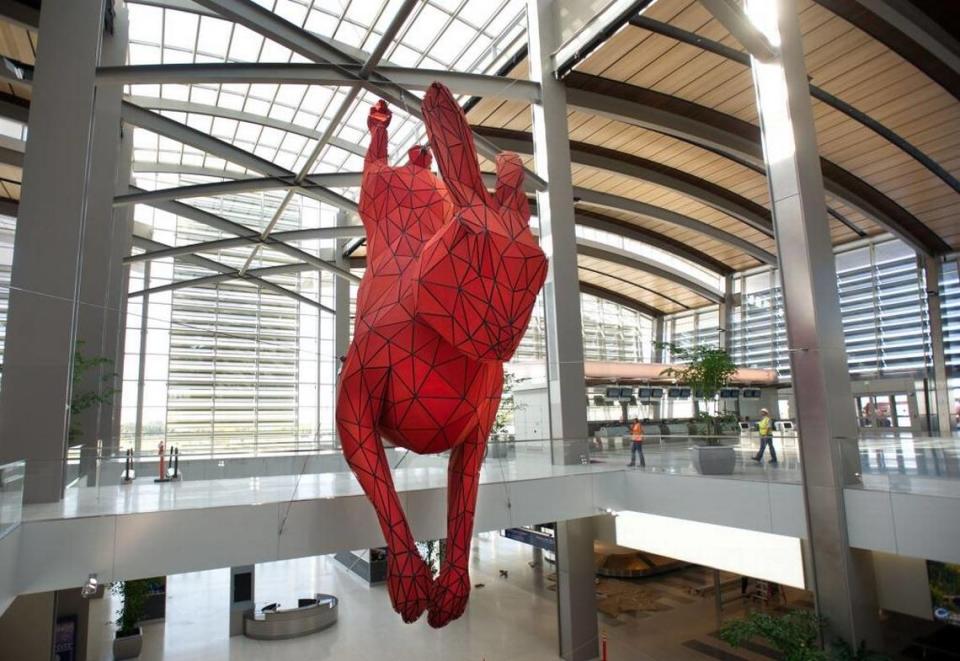
How big is ‘Leap’?
Befitting the grand scale of Terminal B’s three-story central atrium, “Leap” measures 56 feet long. It’s more than 16 feet high and about 14 feet wide.
The rabbit weighs about 10,000 pounds, while the granite luggage weighs 17,000 pounds, Willis said.
In fact, she said, construction crews designed the bottom part of the foundation, or, footing, so it’d be directly under the stone suitcase.
Crews had to maneuver the suitcase into place using a special dolly so the terrazzo flooring wouldn’t get cracked, Willis said.
In order to fit the rabbit through the doors of the terminal, the interior structure was broken into multiple sections and assembled on site.
Then the tiles, each etched with a numbering system, were put together “like a giant jigsaw puzzle,” she said.
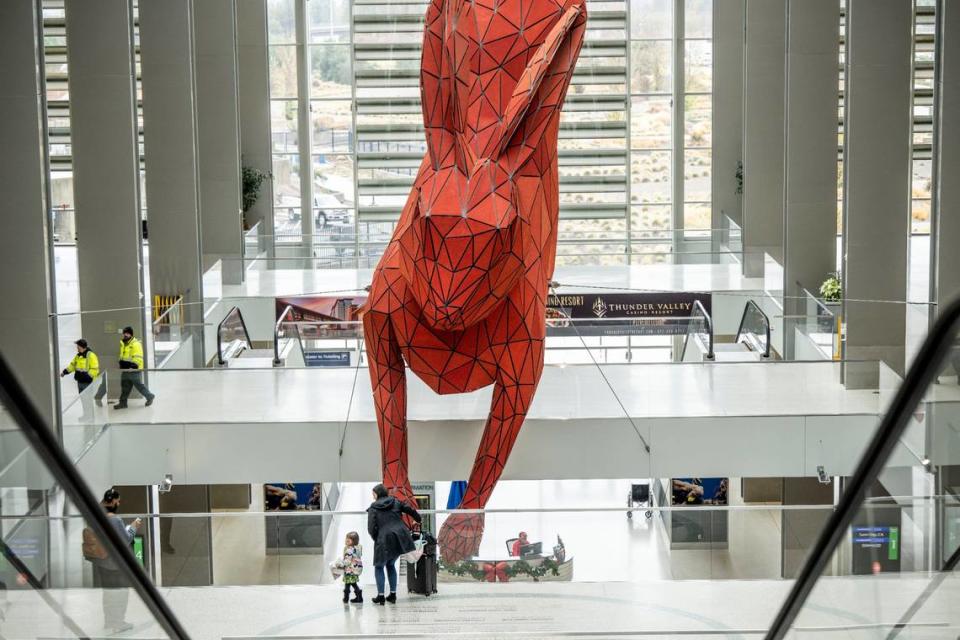
What’s it doing at Sacramento International Airport?
In 1983, Sacramento County established policies allocating 2% of new building construction costs for the purchase of public art — with the goal of expanding the public’s experiences with the visual arts, enhancing their quality of life and helping “create a more visually pleasing human environment,” according to the county Department of Airports.
When the airport broke ground on a $1 billion project to upgrade Sacramento International Airport in 2008, replacing Terminal B, adding gates for jets and building another parking garage, it dedicated $8 million to funding public art installation, according to The Sacramento Bee and the county airports department.
“Leap” alone cost $800,000, The Bee previously reported.
That’s a 10th of the price of the $8 million “Coloring Book #4,” Jeff Koons’ multi-colored, mirror-polished sculpture in front of Sacramento’s Golden 1 Center. It’s more commonly known as “Piglet.”
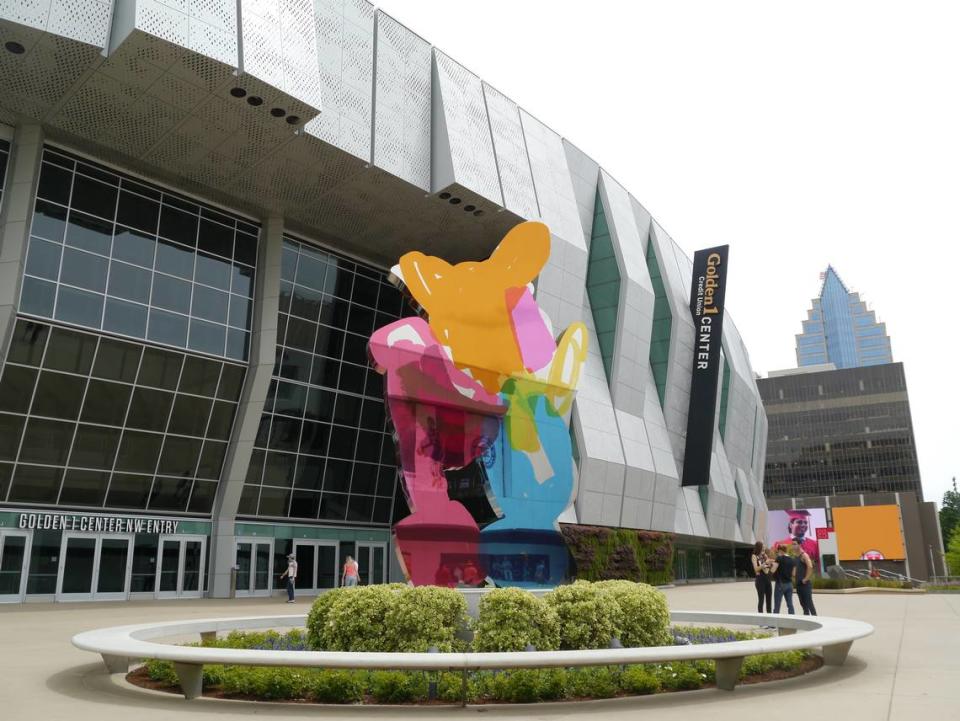
Some county leaders initially balked at “Leap’s” price tag, and felt a big red rabbit wasn’t a good fit for Sacramento.
Multiple members of the Sacramento County Board of Supervisors expressed their misgivings during a 2008 meeting that concluded with a 3-2 vote in favor of Argent’s public art proposal.
“I have a nagging sense that this is not reflective of who we are,” said Supervisor Roger Dickinson, who later became a California State Assembly member.
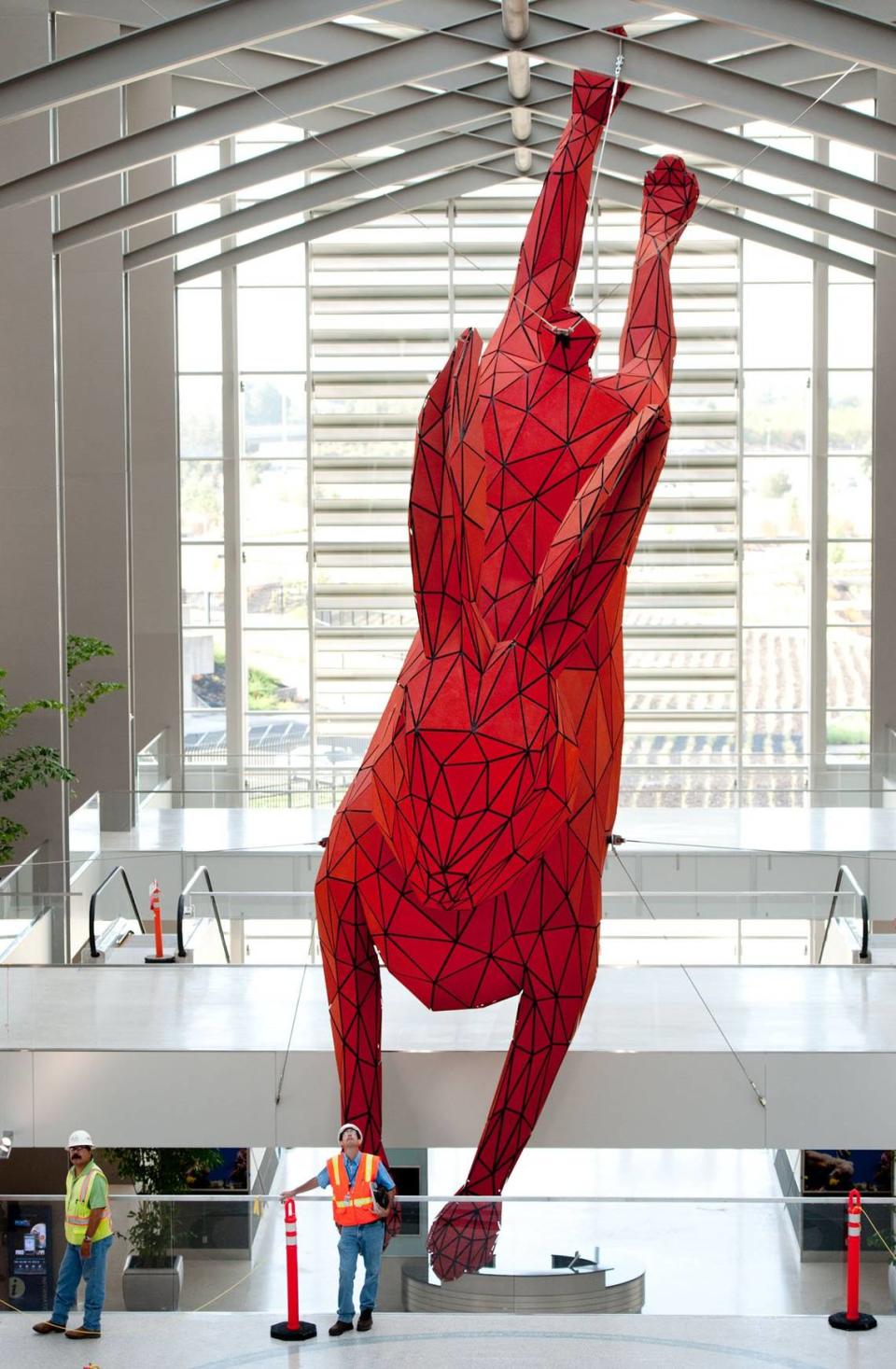
Supervisor Susan Peters also wasn’t a fan of “the bunny,” saying at the time that she feared people would think of rabbits’ “proclivitiy for reproduction.” Why not a cougar or wild turkey?, she asked.
“People don’t respond well to unexpected things and artists are always trying to make unexpected things,” Lancet said, adding that it took courage to greenlight “Leap” despite the controversy. “We benefit from those moments of courage.”
More than a decade later, the red rabbit’s reputation has evolved.
Willis said “Leap” is successful on a number of fronts — serving as a landmark that helps orient travelers and a conversation starter “that people can consider over and over and over again and not (get) tired of.”
Although some public spaces call for artworks that are more subtle and contemplative, other spots require “a big statement that you can take in in a quick amount of time,” Willis said. “That piece does that. That’s why I think it’s brilliant. It accomplishes so much.”
Love it or hate it, Willis said, “Leap” has helped shape Sacramento’s identity.
“Artists give us another way to see ourselves and identify ourselves ... They help us understand the place in a more layered way,” she explained. “Sacramento is the place with a giant red rabbit.”
“It’s fun. It’s whimsical. It’s a little goofy. It makes you smile,” she said. “That’s part of who we are in Sacramento. We’re a welcoming place.”
Lancet, who specializes in Japanese teaware and ikebana vases, said he also appreciates the whimsical nature of the sculpture.
“It’s absolutely the ultimate non sequitur,” he said. “It’s a giant red rabbit in the middle of an airport. There’s no reason for it to be there.”
What other public art can I find at the airport?
Sacramento International Airport is home to more than two dozen public art installations, ranging from Seyed Alavi’s “The Flying Carpet,” which offers an aerial view of the Sacramento River, to “Flying Gardens,” a series of massive bird sculptures by Dennis Oppenheim mounted to the facade of the parking garage.
According to Johnston, one of the most popular public artworks at the airport is Brian Goggin’s “Samson,” which features two 23-foot-tall towers of luggage piled by the Terminal A baggage claim.
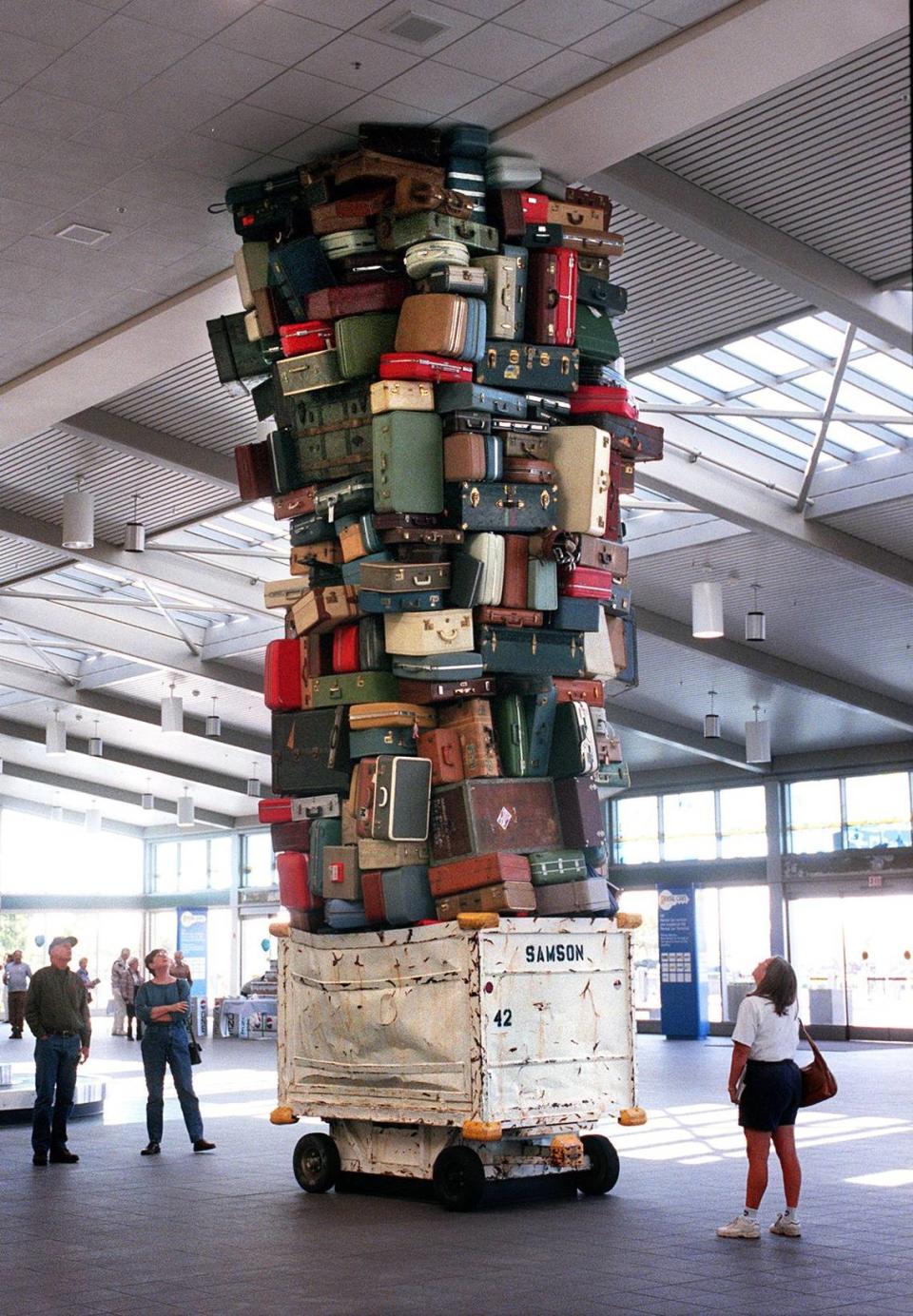
Like “Leap,” it’s become a convenient landmark for travelers.
“People say, ‘Meet me by the suitcases,’ ” Lancet said.
One of Lancet’s favorites is Christian Moeller’s “The Baggage Handlers,” which hangs on a wall inside Terminal B. Made with plywood and steel, it depicts the faces of six airport operation workers.
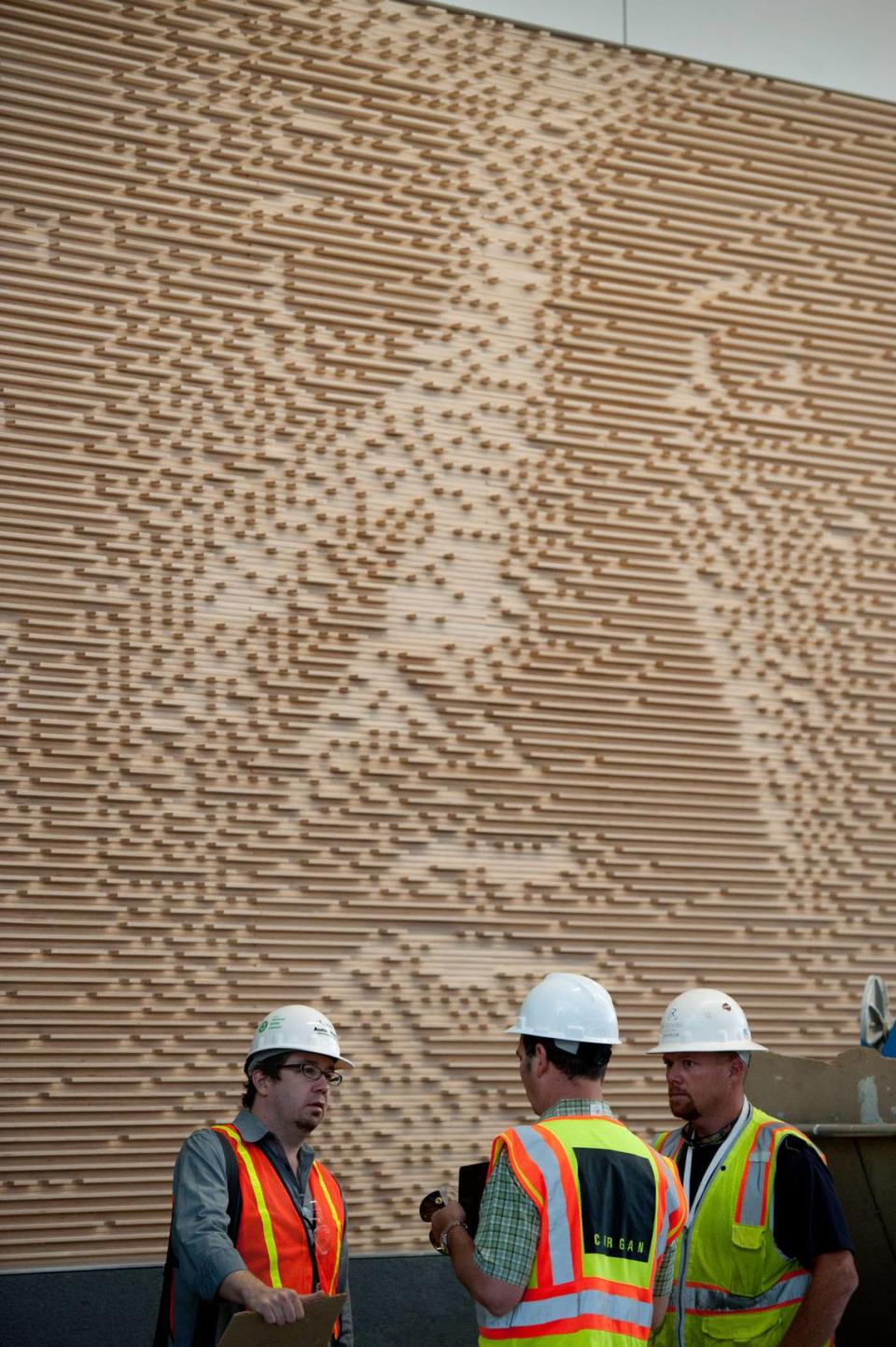
What’s next for airport art collection?
Sacramento International Airport is currently seeking submissions for artworks to grace a new parking garage and pedestrian walkway being constructed as part of SMForward, a $1.3 billion dollar expansion plan.
The airport has set aside approximately $1.75 million for an art piece that will be displayed at the six-story Terminal B Parking Garage.
It’s commissioning three separate art installations — totaling $2 million — for the walkway that will serve as “the major thoroughfare for travelers arriving or departing from Terminal B to and from Concourse B by foot.”
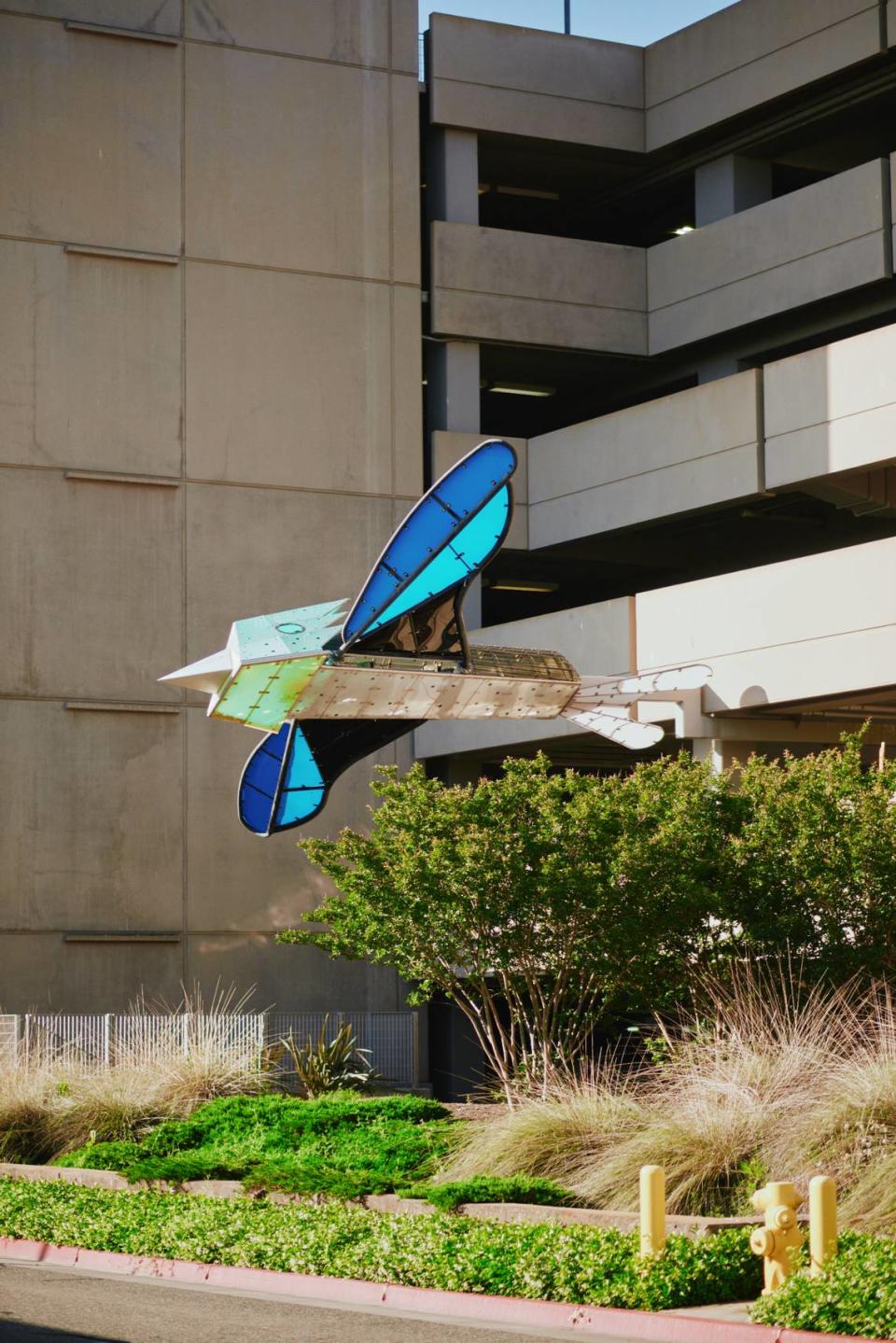
“We would like to have it (the art) installed as the projects are completed,” Johnston said, adding that the airport plans to complete the parking garage and pedestrian walkway by 2026.
Although the window for interested artists to submit qualifications and experience closes Thursday, May 7, Johnston said there will be similar opportunities in the future.
The airport has allotted $2.5 million to fund art installations at the Concourse B Gates, a consolidated rental car facility, a ground transportation center plaza and the walkway from Terminal A to that center, a spokeswoman said.
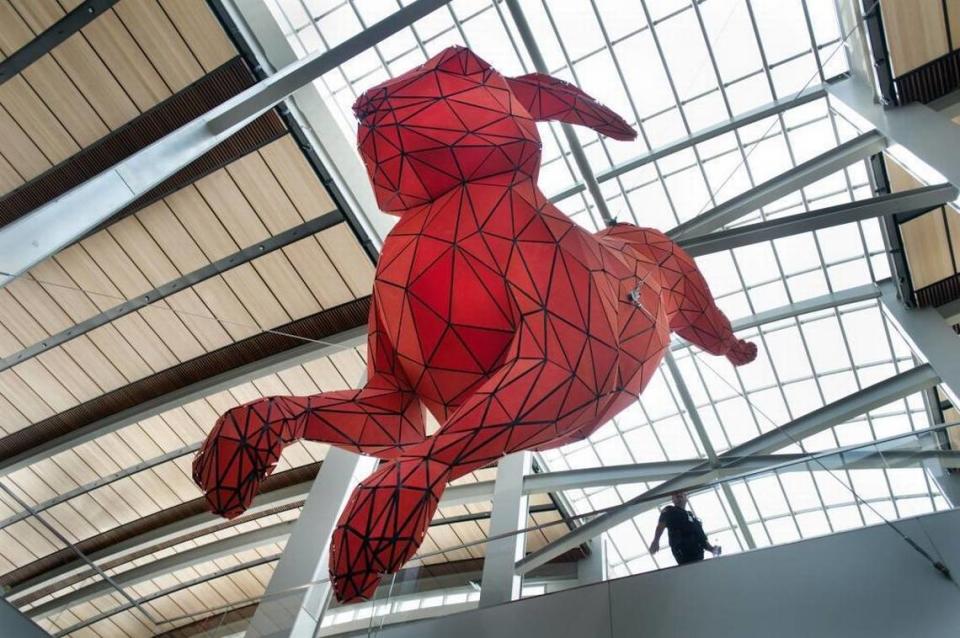
What do you want to know about life in Sacramento? Ask our service journalism team your top-of-mind questions in the module below or email servicejournalists@sacbee.com.


